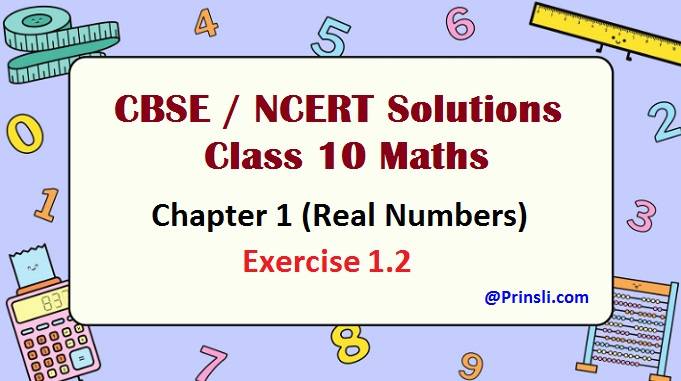
NCERT Solutions For Class 10 Maths Chapter 1 Real Numbers Exercise 1.2
In this article, NCERT Solutions for Class 10 Maths Chapter 1 Exercise 1.2 are given for free. Detailed answers to all the questions in Exercise 1.2 Chapter 1 maths class 10 Real Numbers provided. NCERT Solutions of Class 10 Maths (Real Numbers Ch 1 Ex 1.2) are extremely helpful while doing homework.
Read Also: NCERT Solutions For Class 10 Maths Chapter 1 Exercise 1.1
QUESTION 1 –
Express each number as a product of its prime factors :
(i) 140 (ii) 156 (iii) 3825 (iv) 5005 (v) 7429
SOLUTION –
(i) 140
Use the factor tree as follows to express 140 as a product of its prime factors:
So, the number ‘140’ is factorised as, 140 = 2 × 2 × 5 × 7, that is, 140 = 22 × 5 × 7 as a product of prime factors. Therefore,
140 = 22 × 5 × 7.
(ii) 156
Use the factor tree as follows to express 156 as a product of its prime factors:
So, the number ‘156’ is factorised as, 156 = 2 × 2 × 3 × 13, that is, 156 = 22 × 3 × 13 as a product of prime factors. Therefore,
156 = 22 × 3 × 13.
(iii) 3825
Use the factor tree as follows to express 3825 as a product of its prime factors:
So, the number ‘3825’ is factorised as, 3825 = 3 × 3 × 5 × 5 × 17, that is, 3825 = 32 × 52 × 17 as a product of prime factors. Therefore,
3825 = 32 × 52 × 17.
(iv) 5005
Use the factor tree as follows to express 5005 as a product of its prime factors:
So, the number ‘5005’ is factorised as, 5005 = 5 × 7 × 11 × 13 as a product of prime factors. Therefore,
5005 = 5 × 7 × 11 × 13.
(v) 7429
Use the factor tree as follows to express 7429 as a product of its prime factors:
So, the number ‘7429’ is factorised as, 7429 = 17 × 19 × 23 as a product of prime factors. Therefore,
7429 = 17 × 19 × 23.
QUESTION 2 –
Find the LCM and HCF of the following pairs of integers and verify that,
“LCM × HCF = product of the two numbers”.
(i) 26 and 91
SOLUTION –
First, find the prime factorisation of 26 and 91, that is, express 26 and 91 as a product of its prime factors as follows:
26 = 2 × 13,
91 = 7 × 13.
Therefore,
LCM (26, 91) = 2 × 7 × 13 = 182
HCF (26, 91) = 13
Verification:
LCM × HCF = 182 × 13 = 2366
Product of 26 and 91 = 26 × 91 = 2366
Both values are equal, hence it is verified that, LCM × HCF = Product of the two numbers 26 and 91.
(ii) 510 and 92
SOLUTION –
First, find the prime factorisation of 510 and 92, that is, express 510 and 92 as a product of its prime factors as follows:
510 = 2 × 3 × 5 × 17,
92 = 2 × 2 × 23 = 22 × 23.
Therefore,
LCM (510, 92) = 22 × 3 × 5 × 17 × 23 = 23460
HCF (510, 92) = 2
Verification:
LCM × HCF = 23460 × 2 = 46920
Product of 510 and 92 = 510 × 92 = 46920
Both values are equal, hence it is verified that, LCM × HCF = Product of the two numbers 510 and 92.
(iii) 336 and 54
SOLUTION –
First, find the prime factorisation of 336 and 54, that is, express 336 and 54 as a product of its prime factors as follows:
336 = 2×2×2×2×3×7 = 24×3×7,
54 = 2 × 3 × 3 × 3 = 2×33.
Therefore,
LCM (336, 54) = 24 × 33 × 7 = 3024
HCF (336, 54) = 2 × 3 = 6
Verification:
LCM × HCF = 3024 × 6 = 18144
Product of 336 and 54 = 336 × 54 = 18144
Both values are equal, hence it is verified that, LCM × HCF = Product of the two numbers 336 and 54.
QUESTION 3 –
Find the LCM and HCF of the following integers by applying the prime factorization method.
(i) 12, 15 and 21
SOLUTION –
First, find the prime factorisation of 12, 15 and 21, that is, express 12, 15 and 21 as a product of its prime factors as follows:
12 = 2 × 2 × 3= 22 × 3,
15 = 3 × 5,
21 = 3 × 7.
Therefore,
LCM (12, 15, 21) = 22 × 3 × 5 × 7 = 420
HCF (12, 15, 21) = 3
(ii) 17, 23 and 29
SOLUTION –
First, find the prime factorisation of 17, 23 and 29, that is, express 17, 23 and 29 as a product of its prime factors as follows:
17 = 17 × 1,
23 = 23 × 1,
29 = 29 × 1.
Therefore,
LCM (17, 23, 29) = 17 × 23 × 29 = 11339
HCF (17, 23, 29) = 1
(iii) 8, 9 and 25
SOLUTION –
First, find the prime factorisation of 8, 9 and 25, that is, express 8, 9 and 25 as a product of its prime factors as follows:
8 = 2 × 2 × 2 × 1,
9 = 3 × 3 × 1,
25 = 5 × 5 × 1.
Therefore,
LCM (8, 9, 25) = 2 × 2 × 2 × 3 × 3 × 5 × 5 = 1800
HCF (8, 9, 25) = 1
QUESTION 4 –
Given that HCF (306, 657) = 9, find LCM (306, 657).
SOLUTION –
We know that,
LCM × HCF = Product of the two numbers
That is,
That is,
Substitute HCF (306, 657) = 9 in the last equation and simplify:
Therefore, the answer is,
LCM (306, 657) = 22338.
QUESTION 5 –
Check whether 6n can end with the digit 0 for any natural number n.
SOLUTION –
If the number 6n ends with the digit 0, that is, the unit place of 6n is 0, then it should be divisible by 5 (because any number with the unit place as 0 or 5 is divisible by 5).
This implies that, if the number 6n ends with the digit 0, then 5 is one of the prime factors of 6n.
Since, the prime factorisation of 6n is,
6n = (2 × 3)n,
and it is obvious that, 6n does not contain the prime number 5 for any natural number n,
This implies that, 5 is not a prime factor of 6n, and so the number 6n cannot end with the digit 0 for any natural number n.
Therefore, the number 6n cannot end with the digit 0 for any natural number n.
QUESTION 6 –
Explain why 7 × 11 × 13 + 13 and 7 × 6 × 5 × 4 × 3 × 2 × 1 + 5 are composite numbers.
SOLUTION –
According to the Fundamental Theorem of Arithmetic, “Every composite number can be expressed (factorised) as a product of primes”.
Read Also: Fundamental Theorem of Arithmetic
By definition of a composite number, we know that “a number is a composite number, if it is divisible by a number other than 1 and itself, that is, it has factors other than 1 and itself”.
Consider the given expression;
7 × 11 × 13 + 13.
Take 13 as a common factor, and then we get
7 × 11 × 13 + 13
= 13 × (7 × 11 + 1)
= 13 × (77 + 1)
= 13 × 78
= 13 × 2 × 3 × 13
= 2 × 3 × 13 × 13
Hence, it is clear that this number is expressed as a product of primes.
Since the given expression 7×11×13+13 can be expressed as a product of primes, so 7×11×13+13 is a composite number.
Similarly, consider the given other expression;
7 × 6 × 5 × 4 × 3 × 2 × 1 + 5.
Take 5 as a common factor, and then we get
7 × 6 × 5 × 4 × 3 × 2 × 1 + 5
= 5 × (7 × 6 × 4 × 3 × 2 × 1 + 1)
= 5 × (1008 + 1)
= 5 × 1009
Hence, it is clear that this number is expressed as a product of primes.
Since the given expression 7×6×5×4×3×2×1+5 can be expressed as a product of primes, so 7×6×5×4×3×2×1+5 is a composite number.
QUESTION 7 –
There is a circular path around a sports field. Sonia takes 18 minutes to drive one round of the field, while Ravi takes 12 minutes for the same. Suppose they both start at the same point and at the same time and go in the same direction. After how many minutes will they meet again at the starting point?
SOLUTION –
Because they are both moving in the same direction and at the same time, the method to calculate the time when they will meet again at the starting point is, LCM of 18 and 12.
Now find LCM of 18 and 12 as follows:
The prime factorization of 18 and 12 are,
18 = 2 × 3 × 3 = 2 × 32,
12 = 2 × 2 × 3 = 22× 3.
Therefore,
LCM (18, 12) = 22× 32 = 36
Hence, after 36 minutes, they will meet again at the starting point.
Read Also: Euclid’s division algorithm and how to find HCF in details
- Tags: The first chapter of class 10th maths is Real Numbers. How do you find the HCF of Class 10? NCERT class 10 maths chapter 1 ex 1.2, CBSE ncert class 10 maths chapter 1 exercise 1.2 solutions, ncert class 10 maths ch 1 ex 1.2 solutions, Ex 1.2 Class 10 Maths Question 1, Ex 1.2 Class 10 Maths Question 2, Ex 1.2 Class 10 Maths Question 3, Ex 1.2 Class 10 Maths Question 4, Ex 1.2 Class 10 Maths Question 5, Ex 1.2 Class 10 Maths Question 6, Ex 1.2 Class 10 Maths Question 7
Copyrighted Material © 2019 - 2024 Prinsli.com - All rights reserved
All content on this website is copyrighted. It is prohibited to copy, publish or distribute the content and images of this website through any website, book, newspaper, software, videos, YouTube Channel or any other medium without written permission. You are not authorized to alter, obscure or remove any proprietary information, copyright or logo from this Website in any way. If any of these rules are violated, it will be strongly protested and legal action will be taken.
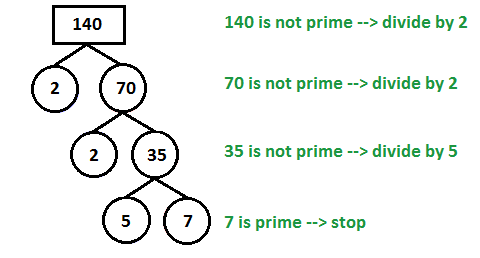
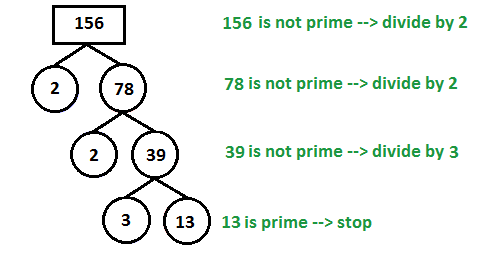
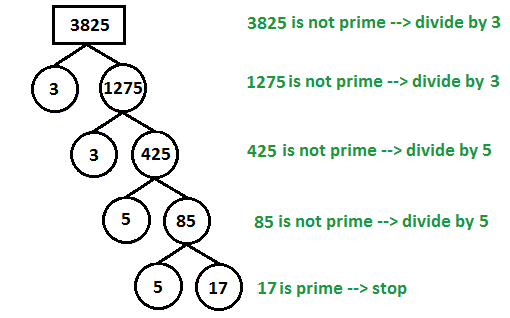
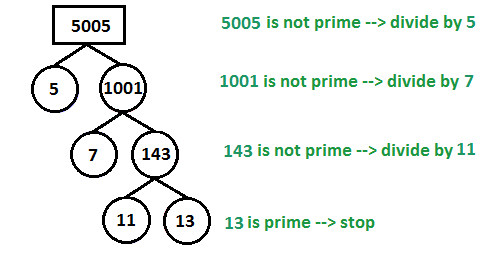
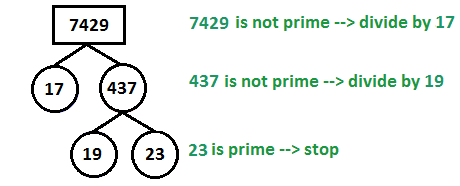




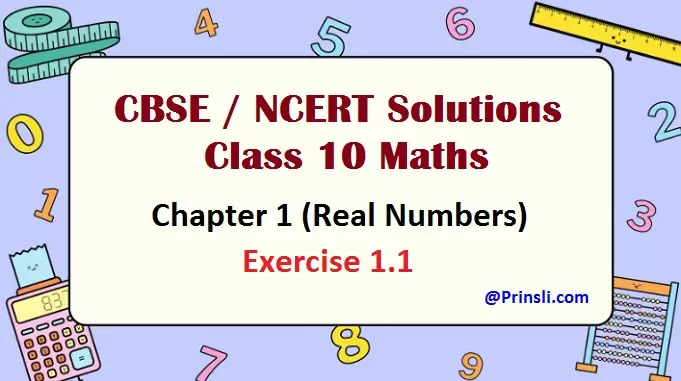
Be the first to comment